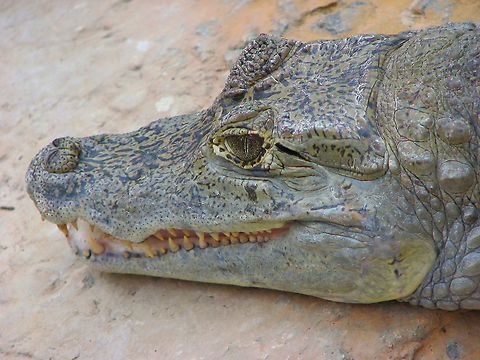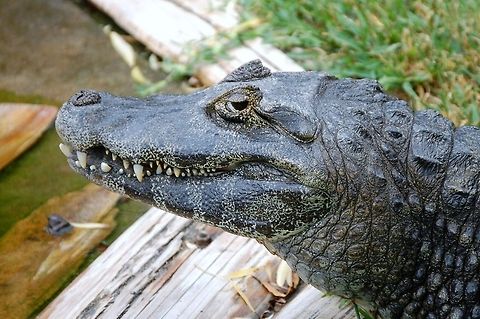
Appearance
While its appearance is very similar to the only other living member of the genus, the American alligator, there are a few differences. One obvious difference is that the Chinese alligator is quite small. Usually this species only attains an adult length of 5 feet and a mass of 80 pounds . Exceptional large males have reached 7 feet in length and 100 pounds in weight. Reports are known of alligators in China reaching 10 feet in centuries past, but these are now generally considered apocryphal. Unlike the American alligator, the Chinese alligator is fully armored; even the belly is armored, which is a feature of only a few crocodilians.
Status
The Chinese alligator is listed as a CITES Appendix I species, which puts extreme restrictions on its trade and exportation throughout the world. It is IUCN Red Listed as a critically endangered species. Efforts are underway to reintroduce captive-bred animals to suitable wild habitats, but thus far have not met with much success.Habitat
While it originally ranged through much of China, this species' wild habitat has been reduced to little more than a few ponds containing 100 to 200 individuals along Lake Tai and the lower Yangtze River in the provinces of Jiangsu, Zhejiang, and Anhui. Its population reduction has been mostly due to conversion of its habitat to agricultural use. A majority of their usual wetland habitats have been turned into rice paddies. Poisoning of rats, which the alligators then eat, has also been blamed for their decline. In the past decade, very few wild nests have been found, and even fewer produced viable offspring.Predators
The Chinese alligator is mainly endangered because of habitat pollution and reduction as their habitat is turned into rice paddies and because of extermination since farmers consider them a menace.In several restaurants and food centers in China's booming areas, young and premature alligators are allowed to roam free with their mouths taped shut. They are subsequently killed for human consumption, as in China alligator meat is thought to cure colds and prevent cancer. In China the organs of the Chinese Alligator are sold as cures for a number of ailments.
This species is widely regarded as quite docile, but, as with any crocodilian, it is capable of inflicting grievous bodily harm.
References:
Some text fragments are auto parsed from Wikipedia.